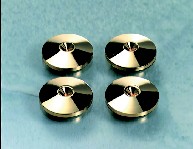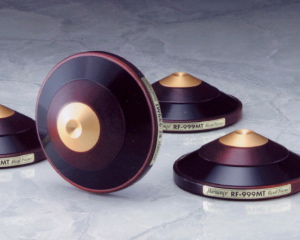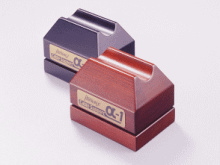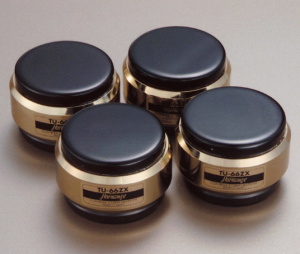You are reading the older HTML site
Positive Feedback ISSUE
14
july/august 2004
harmonix combak
Tuning products, Part 1
as reviewed by Marshall Nack
|
MARSHALL NACK'S SYSTEM
LOUDSPEAKERS
ELECTRONICS
SOURCE
CABLES
ACCESSORIES
|
Adventures with Harmonix accessories: Tuning Spike Bases, Cable Support, Component Footers
"Hey, Sir. You lack substance. You've got great imaging, but, like, where's the beef?" Oy! Perhaps you too have suffered this painful accusation. Perhaps it is still an issue. Well, join the crowd. But wait, here's some very good news: the cure is at hand.
Harmonix RF-900 Tuning Spike Base
The Harmonix Combak Corporation has been making audio tuning accessories for nearly three decades. Their RF 900 Tuning Spike Bases are about the size of a half dollar, made of gold-colored metal with a dimple in the center and a black felt-covered bottom—about what you'd expect for a spike base. They come in sets of four in a little clear plastic box with two pages of instruction in Japanese. Not that there's any secrets to usage. Just slip them under the spike points of your audio gear.

Remember those sexy, seductive recordings by Stan Getz with Astrud and João Gilberto that made Bossa Nova a phenomenon back in the ‘70s? Well, then you'll recognize Entre Amigos (Chesky 90368-0247-2) falling squarely within that genre. I tend to like Entre Amigos even better than the fondly remembered Getz/Gilberto clichés—Getz was a good introduction to this music, but grew to be predictable. His competition is veteran bassist Ron Carter on this CD, who is always doing something interesting. Rosa Passos, like her predecessor Astrud Gilberto, sings in the same breathy Brazilian samba style, but manages to convey the feeling behind the words. She comes across as a mature woman of character, less little girl-like. On most tracks you have an acoustic guitar hard right, another down center played by Rosa, Ron's bass center-left, and percussion center-right. These are simple, but effective arrangements. On track 7, "Por Causa de Voce", only Ron's bass accompanies Rosa. He lays down the chords while she's singing and provides improvisation when she's not, as a guitar or a piano would. He does the job tastefully, without ostentation or cramping Rosa's style, even though the bass EQ is prominent on this CD. The pathos of the song is communicated. Recording quality is very naturalistic—no spotlighting, or post-production gimmickry, another good job from Chesky.

I liked Entre Amigos from first listen, even though playback had some problem areas. Ron's bass was almost out of control, too boomy, and flooding into the mid-range. Rosa's bedroom voice sounded like a breathy whisper, a throat voice without the body attached, in a mezzo-soprano range. The guitars and the sax were good, but the percussion seems to follow the beat and sounded like it was thrown in as an afterthought.
Just replacing the metal spike bases that came with my Kharma CRM 3.2 speakers with a set of the Harmonix RF-900 Tuning Spike Bases unexpectedly addressed all of these issues: first, by giving Rosa a normal voice; second, by controlling and tuning Ron's bass; third, by revealing the space. These major improvements—plus many more little things, like unnoticed acoustic cues and nuances, color and subtle timing improvements—made their appearance through the tuning effects of the RF-900. Surprisingly, the missing "beef" also began to appear. "Just a minute", I hear you say, "How could all this happen from the mere substitution of spike bases?"
According to their brochures, Harmonix engineers began their R & D by studying the resonance characteristics of fine violins in order to "understand how beautiful sound is produced in the first place." They "found that resonance in a violin is perfectly balanced in one frequency."
When you excite one of its strings, the body of the violin doesn't just make the sound louder, it tunes the sound to carefully selected frequencies, and then amplifies it. The engineers applied this to audio products to "eliminate unwanted resonance frequencies to achieve… pure, distortion-free reproduction," through tuning. Theoretically, if you tune resonances and remove noise in an audio system, especially treble noise, the sound you are left with is completely integral with the note. The resulting clean and pure notes are more musically centered, and sound like they are played more accurately. Instrumental lines become easy to follow. It sounds so simple, doesn't it? Tuning your system to imitate the way a violin controls resonance makes such good common sense, doesn't it? Ladies and gentlemen, it took a little while to recognize it, but that is what I heard the RF-900 do.
You will find the treble less prominent, less aggressive and, indeed, more pure. You may not notice that the low-end is subtly reduced, but you will be aware that it is less boomy and its attack has acquired a point, giving it much better articulation. You will definitely notice enhanced weight and fullness. What happened was the non-musical artifacts, the noise, was removed from the frequency extremes and showed up as a commensurate dose of richness in the upper bass through the mid band: this is the missing "beef." Without non-musical artifacts cluttering the stage, the musical details of the presentation are abundant.
Let's get back to Entre Amigos. I should also mention that I heard at least as much of the incidental sounds, like keys flapping, valves opening and closing and chairs scraping, as before. Here's a sampling of some of the things that surfaced after the RF-900 were put in. The sax on "Desafinado" (track 3) now has two distinct components, the note and the breath blowing through the mouthpiece. Both parts emanate from the same source and I can focus my attention on either. I'm used to hearing them mixed together, inseparable, with the breathiness dominant and compromising the note. And now I notice the breathiness I'm used to hearing in Rosa's voice is reduced or eliminated, and what's left of it is now integral with her voice, like what happened with the sax. Anytime breathiness is reduced and tone is enhanced is a good thing. Some curiosities: Rosa's voice is now a large sound source, larger than the guitars, and more forward, although she shares their acoustic space; the drum kit in the far right of the stage has receded. It actually sounds too far away. These are artifacts, just data, revealing how the session was recorded.
Speaker spikes first
Without question the biggest bang for the buck came from replacing the spike bases under the speakers with RF-900, but I also found them good under individual components and even under the rack itself. Here's how I decorated my phono pre-amp, which is already so massively tweaked out as to be a source of concern by visitors. First, it's on the Mapleshade Rack of Samson, with shelves made from solid maple wood and uprights made from heavy steel rods. The bottom end of those steel rods terminates in Mapleshade brass cone points—first application for the RF-900s. The power supply for the phono pre-amp is on the top shelf of the Rack of Samson, on Walker Audio Valid Points—second application. The phono pre-amp main chassis is alongside the power supply, but has an extra four-inch thick maple block and Mapleshade brass conepoints and Isoblocks under it—third point of application. Three sets of RF-900 went in.
I was listening to Handel's Water Musick, one of those late, great Harmonia Mundi LPs (HMU 7010) recorded by Peter McGrath in 1987. Nicholas McGegan and his Philharmonia Baroque Orchestra give a stylish, period instrument performance, which is really the only way the work should be done, the way His Majesty must have heard it circa 1715, while disporting himself on the River Thames. As I've noted elsewhere, this LP has amazing detail and focus, and throws a super dimensional soundstage. Well, musical focus and weight certainly improved, but best of all was the repair work done on string tone. Individual players' skills improved before your eyes (or ears). The melody made more sense as it was passed among each section, and the tune itself became so much more engrossing.
Good performances became better; the converse of that was also true. Lackluster or outright bad performances only became easier to critique. Yes, there is a degree of euphony going on in the beautification of the sound, with aspects similar to what you might get from a really good cable that favors the romantic side. But if the guys aren't playing well, it'll still gonna sound like a bad performance. The RF-900 can't fix a bad performance. They make it sound sweeter, but nothing will correct an out of tune note.
And who's to say that the "dirty" sound of most playback systems is any truer than the tuned sound of a "Harmonized" system? The instruments at the recording venue were tuned, right? When you playback the recording and it sounds noisy—where did that come from? Myself, I don't think about it too much. Like any other audiophile tweak—either they work or they don't.
Another example: I was going back and forth between two versions of a certain manufacturer's top-of-the-line speaker cable, the current offering and a new, upgraded one. My principal reservations about the current version were its grainy texture and a certain tonal thinness. The extra $500 for the new one got you a cable that addressed these issues, along with slightly better performance just about everywhere else, too. I was liking it. One night I came home from work and found two sets of the RF-900 waiting in the mailbox. I promptly deployed them under components on my Solid Tech Rack of Silence. You guessed it; the sound was so improved, it took several minutes to remember that I was listening to the current speaker cable. Along with remedying thinness, I forgot to mention that the RF-900 alleviates graininess.

RF-999MT arrives
Harmonix has come out with a new, improved spike base, the RF-999MT. These upgraded spike bases look beautiful. They are much larger than the RF-900s, with a hybrid layer of cherry wood, metal, and Jacaranda wood finish, as pleasing to the eye as a multi-hued wooden sculpture. What they achieve reminds me of those paint-by-number kits I played with as a kid. Remember those first embarrassing attempts with the paintbrush and what happened after much practice, when you learned to fill in the colors without going outside the outlines? That's about the difference between the RF-900 and the RF-999MT.
On Entre Amigos, fresh colors and believable nuance appeared. Arrival times synched up, and even the tail of the note became more defined (in most systems the end of the note trails off vaguely). Ron Carter's upright bass tightened up some more and became less boomy, but still produced a very satisfying low-end thrust. I watched with analytical glee as Rosa's voice morphed from the breathy whisper I initially heard and described at the beginning of this article, to a voice with a body attached it. She sounded more energetic, less laid-back, like perhaps she had her morning coffee. The metamorphosis happened again when I inserted a run of Kharma Enigma interconnect between DAC and pre-amp, but then, just about every aspect of the performance changed with the addition of the Enigma (stay tuned for Kharma Enigma review).
A beefy, augmented mid-range, integration and control of the frequency extremes, warmth and musical focus—the smaller RF-900 give you all of these and could be just the ticket. Use the RF-999MT if you want to push it further. The RF-999MT's were perfect for my Kharma 3.2s. However, they were too much for my friend's Horning speakers, which are already full in the mid-range; he found a good balance with the RF-900.

A1 Tuning Cable Support - the Power Play
The Harmonix A1s aren't just cable supports. If you put them in expecting better isolation from resonances and floor-borne RF eddy currents, you'd be right, but that's the least they do. They drastically change the characteristic signature of speaker wires and are at least as powerful as the RF-999MT. Their effects are more similar to the Harmonix Enacom AC devices (coming up in a Harmonix Part II review), but go beyond even that. Unlikely as it may seem for a humble cable support, the Harmonix A1 can super-charge dynamics, low-end thrust and fullness. Try them early on, before you acquire other Harmonix products. What with all the Harmonix Tuning I have working along similar lines, their effect was too much for me.

TU-66ZX Component Footers
Like the RF-999MT Spike Bases, the TU-66ZX's are one of a new generation of Harmonix accessories. A composite of cherry wood with an ebony finish and beautiful to look at, they are cylindrical with a flat top and bottom and provide a large contact area with floor and component. They come in sets of four and the manufacturer prefers that you use all of them under a component. You adjust the height of the footer via an adjustable metal base on the bottom. The TU-66ZX is positioned as Harmonix's new flagship component footer.
Careful placement of the TU-66ZX is important, otherwise you may introduce unwanted effects, principally overhanging, or excessively long decay trails. I first placed them in the usual way, as I would any other footer, fully under the chassis of the von Gaylord Audio LAD L2 pre-amp. The result was an un-focused, huge sound with too much energy on the outside of the note and not enough in the center. It was pumped up and gave a sense of being inverted, conjuring up a mental image of melted butter. I moved them so they were half way under the chassis, where half is visible, and the center of the note began to fill in. Finally, I tried them 2/3 to 3/4 out from the chassis, as I saw them used at the In Living Stereo audio salon showroom in Manhattan and their room at the HE 2004 show. This got the ratio right between center and periphery sounds. Later on, I found an even better setup, with the RF-66ZX fully under the pre-amp and a slab of maple wood under them.
As you might expect, the footers' effects are similar to the other Harmonix products already described. In particular, the TU-66ZX delivered great string tone and gave instruments a kind of musical focus from the tuning effect, but this has nothing to do with sharply defined, point source images on the soundstage. They didn't do what audiophiles expect in terms of image focus, which was hazy compared to some of the competing pointy feet. I wanted both types of focus. I decided to experiment with some of the other Harmonix footers, of which there are about six different models.
I swapped the TU-66ZX from under the pre-amp with a set of TU-505EX, a flat footer that comes with mini RF-900-like spike bases. This gave me more focus and treble extension, but the downside was the introduction of some treble shrillness and a loss of body. The TU-505EX rotated to under the Shunyata Hydra, replacing a set of older Harmonix RFS-66 feet (now discontinued), and the TU-66ZX went back under the pre-amp. This was muy bueno: I got more of both kinds of focus and body improved. Two more Harmonix footers with pointy feet are en route now. We'll see what they do in Part II of the review coming soon. By the way, the performance of the older generation of footers, like the RFS-66, is not even close to the next-gen TU-66ZX or RF-999MT.
In another application, under the von Gaylord Nirvana MkII tube amps, I tried the TU-202 ZX and the TU-201 footers, before discovering the TU-66ZX. Neither of these worked out; the TU-202 ZX imparted much too much bloom and did something to make reverberation trails last forever. The TU-201 did the same thing, but even more so. Note that the TU-202 ZX worked very well under the Lamm ML.1.1 mono blocks. You will need to experiment with several products before you hit the optimal mix. Don't acquire one and form an opinion about the whole line.
Caveat Emptor: be careful not to go overboard. Signs that you've gone too far include a sense of too much control—to the point where the music lacks vitality, the presentation shrinks, the frequency extremes dry up, and the mid-range dominates. The life in the sound is gone. Equally to be avoided is a sound that's too big, pumped up and larger than life. This is a sign that you haven't achieved good karma in your Harmonix selections.
Conclusion
I have to say, I'm very happy with my assortment of Harmonix tuning devices. With their help, I'm getting the best sound I've ever had. The proof is when my critical pals come over and their only comment is "This is great sound." The devices deal with problem areas I've been battling for years: the major improvements are the banishment of brightness and the augmentation of body and fullness. Brightness seems to be ubiquitous in high definition audio; pick up any high-end review and chances are it will contain some discussion of brightness. Likewise, most systems lack body. The Harmonix devices are the most effective treatment for these maladies I know. And they throw in side bennies of musical focus, clarity, tonal richness, more nuance and increased dynamics.
Let's face it, though; this is an awful lot of money for a bunch of footers. The RF-999MT and the TU-66ZX have an MSRP of $865 a set, while the RF-900 comes in at $235 a set. I wish I could get these results more cheaply, but nothing else does the job. So for me, there's no choice, because going back to my old bugaboos is out of the question. The assorted Harmonix tuning accessories—RF-900, RF-999 MT and TU-66ZX—have replaced the whole gamut of my reference footers. I'm keeping the lot of them.
Follow up: the Harmonix RFA-78i Room Tuning Discs
I think I unknowingly short-changed the RFA-78i Room Tuning Discs in my recent review. I took my clue from the instruction sheet, which said the discs work best when all other room treatments are removed. So with the RFA-78i in place as described in my review, I removed the first reflection point damping material on the sidewalls. I found the result was worse than with the damping material in place. That's how I arrived at the conclusion to leave my room treatment as is.
Well, for unrelated reasons, I had to remove some other room treatment. I had large diffuser panels catty-cornered from floor to ceiling in the front room corners and these came out. I've done this before and knew what effect this would have; I wasn't expecting to hear great sound. Sure enough, the focus was gone and the soundstage was smeared. But there was noticeably more body. The problem was how to retain that body and still get definition? At this point, I threw three RFA-78i discs into each front ceiling corner, as the brochure recommended.
Lo and behold, magically the sound became big, room filling, with detail and stage definition nearly as good as when the big diffusers were in place, and the body was preserved. Big gains were apparent in treble quality—it was smoother and had more flesh on it and stopped wandering and wavering around. This part of the image's frequency spectrum lined up better with the mid-range and bass. The Harmonix promotional material was also right about dynamics becoming super charged. The old sound with the diffusors was kind of pristine and precious, very controlled and contained. With the diffusors out and the RFA-78i in, I had the best of both. In the end, the only treatment left in place was a bass trap in the front left corner and those same sidewall absorbers I originally took out. This was great: the eyesore diffusors are finally gone! Marshall Nack
Harmonix RF-900
Tuning Spike Base
Box of 4: $235
Harmonix RF-999MT Tuning
Spike Base
Hybrid layers of
Cherry wood and metal with a Jacaranda wood finish.
77mm dia.(bottom) x 22mm(H)
Box of 4: $865
Harmonix A1 Tuning Cable Support
Hybrid layers of
Cherry wood and metal with a Jacaranda wood finish.
77mm dia.(bottom) x 22mm(H)
Set of 2: $865
Harmonix TU-66ZX Component Footers
Cherry wood with
metal base, Ebony finish.
50mm dia. x 33mm
Box of 4: $865
Harmonix Combak Corporation
4-20, Ikego 2-chome, Zushi-shi
Kanagawa 249-0003
Japan
TEL: (81) 468. 72. 1119
email address:
[email protected]
web address:
www.combak.net
US Distributor
May
Audio Marketing, Inc
Niagara
Falls NY 14304
TEL: 716. 283. 4434
email address:
[email protected]
web address: www.mayaudio.com
